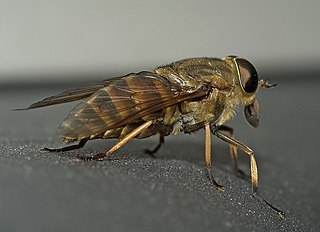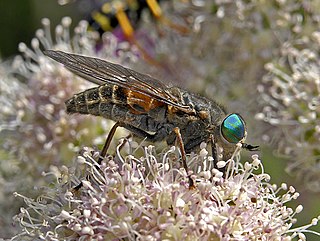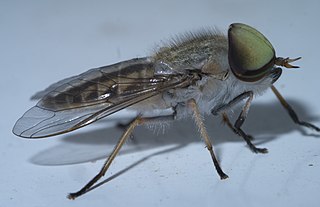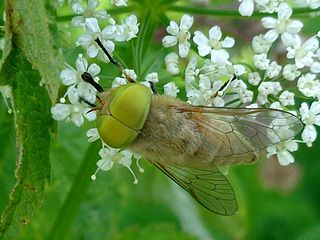
Horse-flies and deer flies are true flies in the family Tabanidae in the insect order Diptera. The adults are often large and agile in flight. Only female horseflies bite land vertebrates, including humans, to obtain blood. They prefer to fly in sunlight, avoiding dark and shady areas, and are inactive at night. They are found all over the world except for some islands and the polar regions. Both horse-flies and botflies (Oestridae) are sometimes referred to as gadflies.

Tabanus is a genus of biting horseflies of the family Tabanidae. Females have scissor-like mouthparts that are able to penetrate the skin of livestock animals. The horsefly can then extract and ingest the animal's blood. Horseflies of this genus are known to be potential vectors of anthrax, worms and trypanosomes. Some species, such as Tabanus bovinus, prefer bovine animals and are less harmful to humans. The genus contains hundreds of species and many species groups.

Tabanus nigrovittatus, also known as the greenhead horse fly, salt marsh greenhead, or simply the greenhead fly, greenhead or greenfly, is a species of horse-fly commonly found around the coastal marshes and wetlands of the Eastern United States. They are smaller than most horsefly species, instead being close in size to a common housefly. The biting females are a considerable pest to both humans and animals while they seek a source of blood protein to produce additional eggs: greenhead larvae develop in the mud of salt marshes, and adult flies mate and lay their first group of eggs in the marsh, but to lay more eggs a female fly needs to drink an animal's blood, and so female greenheads which have laid eggs fly inland to look for prey in the area bordering the marsh; they can stay on land looking for animals to bite for up to four weeks. Their bites itch, like those of mosquitoes, but are more painful, since greenheads feed by cutting a wound in the skin with scissor-like mouth parts and sucking the blood released through it. Females live for three to four weeks and may lay about 100 to 200 eggs per blood meal. The eggs are laid on the grass in a salt marsh; the larvae live in the intertidal mud of the salt marsh for one or two years, preying on other invertebrates, before pupating in early spring. The adult flies emerge in late spring and are most common from late June to August.

Tabanus sudeticus, also known as the dark giant horsefly, is a species of biting horse-fly. It is the heaviest fly in Europe.

Haematopota pluvialis, the common horse fly or notch-horned cleg fly, or simply cleg in Scotland and northern parts of Ireland, is a species belonging to the family Tabanidae subfamily Tabaninae.
Cornelius Becker Philip (1900–1987) was an American entomologist, noted for assigning comedic names to species he described.

Hybomitra montana, the slender-horned horsefly, is a species of horse flies in the family Tabanidae.

Haematopota pseudolusitanica is a species of horse fly in the family Tabanidae.

Tabaninae is a subfamily in the family Tabanidae commonly known as horse flies. There are more than 3000 described species in Tabaninae.

Diachlorini is a tribe of horse flies in the family Tabanidae.

Atylotus is a genus of horse flies in the family Tabanidae.
Agkistrocerus is a genus of horse flies in the family Tabanidae.
Anacimas limbellatus is a species of horse flies in the family Tabanidae.
Anacimas is a genus of horse flies in the family Tabanidae.
Hybomitra sonomensis is a species of horse flies in the family Tabanidae.

Tabanus fairchildi, Fairchild's horse fly, is a species of horse fly in the family Tabanidae.
Hybomitra astuta is a species of horse flies in the family Tabanidae.
Hybomitra fulvilateralis is a species of horse flies in the family Tabanidae.
Teskeyellus is a genus of horse flies in the family Tabanidae.











